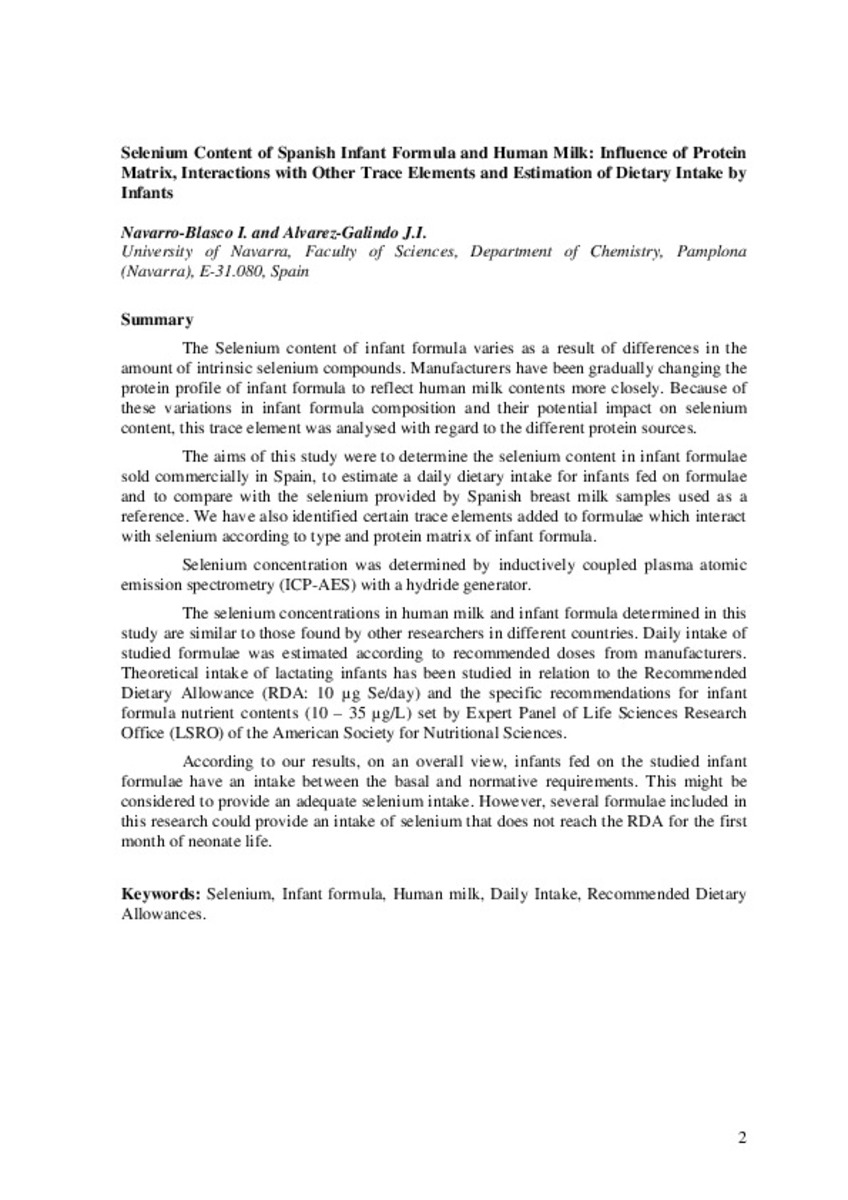Full metadata record
| DC Field | Value | Language |
|---|---|---|
| dc.creator | Navarro-Blasco, I. (Iñigo) | - |
| dc.creator | Alvarez-Galindo, J.I. (José Ignacio) | - |
| dc.date.accessioned | 2017-12-14T17:10:13Z | - |
| dc.date.available | 2017-12-14T17:10:13Z | - |
| dc.date.issued | 2004 | - |
| dc.identifier.citation | Navarro-Blasco, I. (Íñigo); Alvarez, J.I. (José Ignacio). "Selenium Content of Spanish Infant Formulae and Human Milk: Influence of Protein Matrix, Interactions with Other Trace Elements and Estimation of Dietary Intake by Infants". J Trace Elem Med Biol. 2004;17(4):277-89. | es |
| dc.identifier.uri | https://hdl.handle.net/10171/45024 | - |
| dc.description.abstract | The Selenium content of infant formulae varies as a result of differences in the amount of intrinsic selenium compounds. Manufacturers have been gradually changing the protein profile of infant formula to reflect human milk contents more closely. Because of these variations in infant formula composition and their potential impact on selenium content, this trace element was analysed with regard to the different protein sources. The aims of this study were to determine the selenium content in infant formulae sold commercially in Spain, to estimate a daily dietary intake for infants fed on formulae and to compare with the selenium provided by Spanish breast milk samples used as a reference. We have also identified certain trace elements added to formulae which interact with selenium according to type and protein matrix of infant formula. Selenium concentration was determined by inductively coupled plasma atomic emission spectrometry (ICP-AES) with a hydride generator. The selenium concentrations in human milk and infant formula determined in this study are similar to those found by other researchers in different countries. Daily intake of studied formulae was estimated according to recommended doses from manufacturers. Theoretical intake of lactating infants has been studied in relation to the Recommended Dietary Allowance (RDA: 10 μg Se/day) and the specific recommendations for infant formula nutrient contents (10 – 35 μg/L) set by Expert Panel of Life Sciences Research Office (LSRO) of the American Society for Nutritional Sciences. According to our results, on an overall view, infants fed on the studied infant formulae have an intake between the basal and normative requirements. This might be considered to provide an adequate selenium intake. However, several formulae included in this research could provide an intake of selenium that does not reach the RDA for the first month of neonate life. | es_ES |
| dc.language.iso | eng | es_ES |
| dc.rights | info:eu-repo/semantics/openAccess | es_ES |
| dc.subject | Selenium | es_ES |
| dc.subject | Infant formula | es_ES |
| dc.subject | Human milk | es_ES |
| dc.subject | Daily Intake | es_ES |
| dc.subject | Recommended Dietary Allowances | es_ES |
| dc.subject | Selenium | - |
| dc.title | Selenium Content of Spanish Infant Formulae and Human Milk: Influence of Protein Matrix, Interactions with Other Trace Elements and Estimation of Dietary Intake by Infants | es_ES |
| dc.type | info:eu-repo/semantics/article | es_ES |
Files in This Item:
Statistics and impact
Items in Dadun are protected by copyright, with all rights reserved, unless otherwise indicated.






